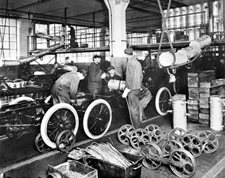Advantages And Disadvantages Of Division Of Labour. Get Valid Information On The Advantages As Well As The Disadvantages Of Division Of Labour. Check This Post Now.

Do you want to know the numerous advantages and disadvantages of division of labour? Do you want to know the importance of division of labour? Then this article is for you, as we will be discussing the advantages and disadvantages of division of labour.
What Is Division Of Labour?
Division of labour is defined as the breaking down of a production process into a number of separate operations, whereby each operation is undertaken or performed by one person or a group of persons. It is the separation of a work process into a number of tasks, with each task performed by a separate person or group of persons. It is the separation of the tasks in any economic system or organization so that participants may specialize.
What Are The Advantages Of Division Of Labour?
We all know that division of labour refers to different workers performing different tasks in the course of producing a good or service. In this article, we will be giving you the benefits of division of labour.
- Increased Output
- Less Wastage
- Lower Unit Costs
- Time Saving
- Large Scale Production
- Less Fatigue
- Creation Of Employment Opportunities
- Production Of Quality Goods
- Development Of Greater Skill
Advantages Of Division Of Labour
1. Increased Output
Workers that specialize in a particular field can be more efficient during the production process, because most workers have gained more skills and experience, they can now produce more output than expected.
Read Also: 15 Importance Of Separation Of Powers
2. Less Wastage
Division of labour eradicates wastage of resources, as workers become more specialized in performing a task during the production process, their errors are significantly reduced.
3. Lower Unit Costs
We all know that division of labour leads to greater productivity, meaning large quantities are produced in less time, the unit cost of the product will be less.
4. Time Saving
Division of labour makes production faster and it saves time too.
5. Large Scale Production
Division of labour paves way for multiple and large scale production, because the hands are more plenty now, then there will be increase in production.
6. Less Fatigue
In division of labour, since the works are divided to different people and people now work with the use of machines, they do not get tired easily.
7. Creation Of Employment Opportunities
Another advantage of division of labour is that it creates room for more employment opportunities, as more masses are been employed and integrated into the working system.
8. Production Of Quality Goods
Division of labour helps in the production of quality and standard goods which possess the same specifications like color, size, shape, weight, etc.
9. Development Of Greater Skill
Last advantage on our list is the development of a worker in any profession. Division of labour helps workers develop greater skill and experience through repeating the same process.
Read Also: Hard Rock Nick Net Worth 2023 Forbes, Real Name And Age
What Are The Disadvantages Of Division Of Labour?
There are also demerits of division of labour and we have outlines some of them;
- Reduction In Employment Opportunities
- Problem Of Mobility Of Labour
- Problem From Increased Interdependence
- Decline In Skills
- Changes In Fashion And Taste
- Limited Resources
Disadvantages Of Division Of Labour
1. Reduction In Employment Opportunities
Just like in the advantage, this can also affect the system negatively, because in division of labour, machines are been utilized, this results in the level of employment, as few staffs alongside machines are been used.
2. Problem Of Mobility Of Labour
This is another demerit of division of labour, it is totally bad for a worker to stay on a job for too long, this can make it difficult for the worker to consider other opportunities.
3. Problem From Increased Interdependence
Division of labour has meant that workers and industries may have to depend on one other before production can move on, absence of such workers may affect the system and can even close the entire business.
4. Decline In Skills
Because most workers are now more used to machines and tools, they can no longer practice and utilize their skills, therefore causing a decline in their craft and skills.
5. Changes In Fashion And Taste
This can be another disadvantage of division of labour, taste and trending styles can change at any time.
6. Limited Resources
Having too specialized labour in industries that require extensive use of limited resources might be a problem in the long term.
Read Also: Jennifer Earles, The Beautiful Ex-Wife Of Jason Earles And More About Her
Conclusion
In division of labour, the importance can never be underestimated, it is very important for the effectiveness of any business, as joint heads are better than one, as there will obviously be an efficient and larger outcome, there is no doubt that division of labour often leads to increase in production because the various experts along the production process work together to boost greater productivity.
Frequently Asked Questions.
1. What Is The Concept Of Division Of Labor?
The division of labor refers to the segmentation of tasks, so each person focuses on a specific part of the production process.
2. What Are The Classifications Of Labor?
Classifications of labor include: laborers, specialty equipment operators, heavy equipment operators, truck drivers and specialty crafts.
3. Is CEO An Employee?
The CEO is the highest-ranking employee within any organization.
4. Who Can Fire The CEO?
The board of directors.
5. Who Appoints A CEO?
The CEO is typically appointed by the board of directors and is the person in charge of overall day-to-day management of a company.